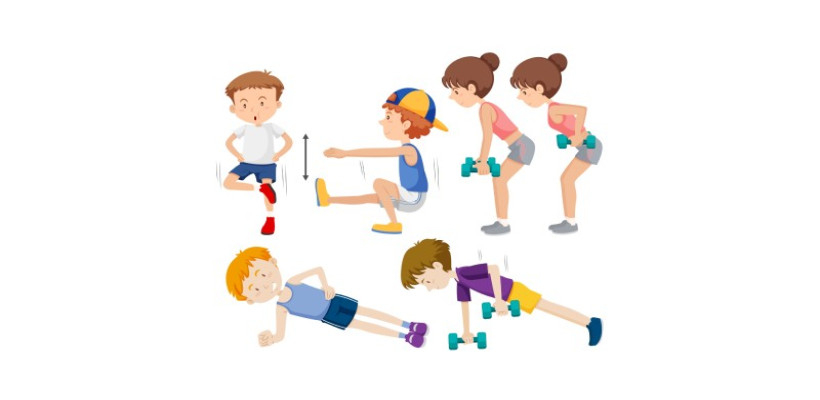Beginner Circuit Training Workout Routine for Strength & Endurance
- 25 Dec 2023
- -

Circuit exercise will put your body to work. Here's a circuit training workout plan for beginners to help you attain your fitness goals.

Circuit exercise will put your body to work. Here's a circuit training workout plan for beginners to help you attain your fitness goals.
The days of doing one set at a time on a stand-alone strength machine are long gone. Fortunately, the emphasis is shifting away from single-joint workouts and toward three-dimensional movement of the body. Because we live in a three-dimensional environment, the body must move in all ranges of motion rather than just one.
Designing a training program that includes movements that move the body forward, back, side to side, and twisting helps the body to adapt to movement patterns that occur outside of the gym. When we train in all ranges of motion, the body is prepared to move safely and confidently throughout the day, reducing the possibility of injury.
If you're new to training or returning after a lengthy break, a thorough circuit program that focuses on technique, works your body in all directions, and targets all of the major muscle groups is a good place to start.
Circuit training is a type of programming that consists of a certain number of exercises (five to ten) repeated back to back for a predetermined amount of time, followed by brief intervals of rest. High-Intensity Interval Training (HIIT) is sometimes mistaken with circuit training. While both provide some flexibility and creativity, there are significant distinctions.
Boredom is one of the most prevalent obstacles with exercise, as is remaining motivated and consistent over time, and learning to design a safe regimen. It's difficult to become bored when you have to focus on good technique, muscle activation, counting repetitions, or monitoring the time as you move from one exercise to the next. You will tackle these problems and feel driven to keep continuing as your confidence grows with a well-designed circuit curriculum.
I employ circuit training to keep clients from becoming bored, to help them prevent unnecessary injuries, to help them recover from existing injuries, to increase cardiovascular fitness and strength, mobility, flexibility, and general body awareness and control. If you're short on time and want to improve the efficiency and efficacy of your exercises, circuit training can help.
Please keep in mind that if you are not used to working out at a higher intensity, you should start cautiously and always speak with a professional and your doctor before beginning any workout to ensure it is a good place to start.
Remove all of the guesswork from constructing a circuit program. Once you've figured out how to put your software together, the possibilities are limitless. When developing your program, keep the following things in mind: current fitness level, physical limits, objectives, equipment, and time available.
Every time I adjust my schedule, I start simple and work my way up. To get you started, here's a basic plan that uses only your body weight. You may make changes when your variables change.
Determine how many sets, repetitions, or time you will devote to each exercise based on your current fitness level and time constraints.
Warm up before commencing any workout program, and relax for one minute after completing each complete set of exercises.
Select two from each group:
Here's an example of a circuit training routine that combines all of the components outlined in stages one and two.
Beginner: 1-2 sets of 30 seconds of work followed by 20 seconds of rest (per side if applicable).
1. Elevated Push-Up
2. Bear Crawl Hold
3. Squats
4. Deadlifts
5. Forearm Plank Rock
6. Single-Leg Jack Knife
7. High Knee Skips
8. Side to Side Shuffle
I've created a progressive complete body circuit training routine that you can start right away to improve your strength, flexibility, mobility, and endurance. There are three circuit training sets, each with three stages. For four weeks, complete each level of the program once or twice a week. Move on to the next step once you've mastered the first.
Slow down and adapt each movement if you are new to exercise and want to work on technique. If you can't accomplish a push-up on the floor, elevate it using your kitchen counter or coffee table. Do you not want to jump? No worries. Perform jump squats, step-out jacks, or fake jump rope with alternating forward steps.
As you develop, lower the height of the table for push-ups, reintroduce the leap, or raise the pace and number of repetitions performed within the time limit. The most essential thing is to learn each exercise safely and with enjoyment.
If you've been consistently working out with good technique for more than four to six months, it's time for a well-deserved improvement. However, if you are at home with limited equipment, increasing extra overload (an important idea in strength training to improve muscle growth and strength and a whole other issue) is difficult but not impossible.
Gaining strength and muscle as a novice who works out consistently is very straightforward since you progress from occasional activity to becoming more serious and structured about your efforts. As you gain strength, you will need to be more creative with your programming and gradually increase the difficulty of the workouts.
If you're not adding more weight, time under strain is one of the finest ways to go in the table above. I'd also include a few of isometric holds inside the 60-second time frame. For example, do five push-ups, hold for five seconds at the contraction phase, and then do five more push-ups. For the rest of the time, repeat this sequence.
Don't be put off by circuit training routines. Starting with a few exercises and progressing at your own pace is a terrific place to start. It will keep you intrigued as you go from one workout to the next.
Share Your Thoughts 0